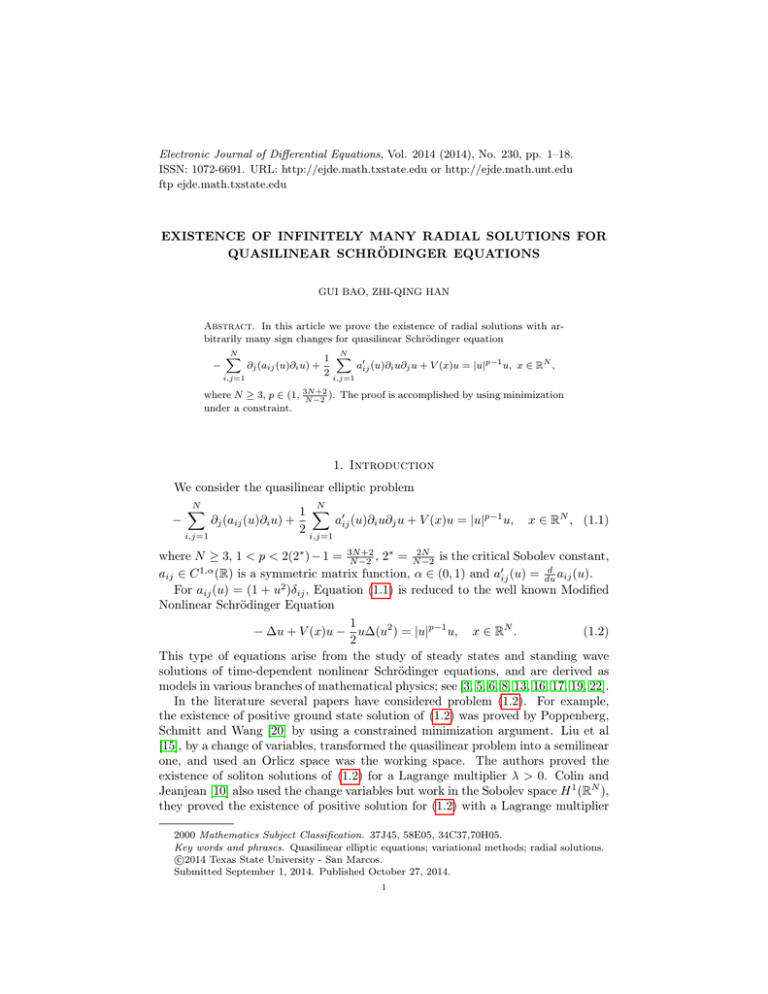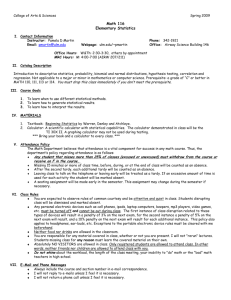Electronic Journal of Differential Equations, Vol. 2014 (2014), No. 230,... ISSN: 1072-6691. URL: or
advertisement

Electronic Journal of Differential Equations, Vol. 2014 (2014), No. 230, pp. 1–18.
ISSN: 1072-6691. URL: http://ejde.math.txstate.edu or http://ejde.math.unt.edu
ftp ejde.math.txstate.edu
EXISTENCE OF INFINITELY MANY RADIAL SOLUTIONS FOR
QUASILINEAR SCHRÖDINGER EQUATIONS
GUI BAO, ZHI-QING HAN
Abstract. In this article we prove the existence of radial solutions with arbitrarily many sign changes for quasilinear Schrödinger equation
−
N
X
∂j (aij (u)∂i u) +
i,j=1
where N ≥ 3, p ∈ (1,
under a constraint.
N
1 X 0
a (u)∂i u∂j u + V (x)u = |u|p−1 u, x ∈ RN ,
2 i,j=1 ij
3N +2
).
N −2
The proof is accomplished by using minimization
1. Introduction
We consider the quasilinear elliptic problem
−
N
X
i,j=1
∂j (aij (u)∂i u) +
N
1 X 0
a (u)∂i u∂j u + V (x)u = |u|p−1 u,
2 i,j=1 ij
x ∈ RN , (1.1)
+2
2N
∗
where N ≥ 3, 1 < p < 2(2∗ ) − 1 = 3N
N −2 , 2 = N −2 is the critical Sobolev constant,
d
aij ∈ C 1,α (R) is a symmetric matrix function, α ∈ (0, 1) and a0ij (u) = du
aij (u).
2
For aij (u) = (1 + u )δij , Equation (1.1) is reduced to the well known Modified
Nonlinear Schrödinger Equation
1
− ∆u + V (x)u − u∆(u2 ) = |u|p−1 u, x ∈ RN .
(1.2)
2
This type of equations arise from the study of steady states and standing wave
solutions of time-dependent nonlinear Schrödinger equations, and are derived as
models in various branches of mathematical physics; see [3, 5, 6, 8, 13, 16, 17, 19, 22].
In the literature several papers have considered problem (1.2). For example,
the existence of positive ground state solution of (1.2) was proved by Poppenberg,
Schmitt and Wang [20] by using a constrained minimization argument. Liu et al
[15], by a change of variables, transformed the quasilinear problem into a semilinear
one, and used an Orlicz space was the working space. The authors proved the
existence of soliton solutions of (1.2) for a Lagrange multiplier λ > 0. Colin and
Jeanjean [10] also used the change variables but work in the Sobolev space H 1 (RN ),
they proved the existence of positive solution for (1.2) with a Lagrange multiplier
2000 Mathematics Subject Classification. 37J45, 58E05, 34C37,70H05.
Key words and phrases. Quasilinear elliptic equations; variational methods; radial solutions.
c
2014
Texas State University - San Marcos.
Submitted September 1, 2014. Published October 27, 2014.
1
2
G. BAO, Z.-Q. HAN
EJDE-2014/230
appears in the equation. The same method of changing variables was also used
recently to obtain the existence of infinitely many solutions of problem (1.2) in
[12]. See also [4] for the existence of positive solutions of problem (1.2) for the case
of critical growth.
main mathematical difficulties with problem (1.2) are caused by the term
R The
2
2
u
|∇u|
dx which is not convex. A further problem is caused by usual lack of
N
R
compactness since these problems are dealt with in the whole RN .
In this article, we consider a general problem (1.1). Under a certain constraint, we prove that (1.1) possess infinitely many sign-changing solutions for
+2
p ∈ (1, 3N
N −2 ). As far as we know, besides [14], there are very few results for
the existence of sign-changing solutions for (1.1). However, we point out that in
[14], solutions are founded in the case p ≥ 3.
Throughout this article, we denote the positive constants (possibly different) by
C, C1 , C2 , . . . . First we state the following assumptions.
(V1) V (x) ∈ C α (RN ) is a radially symmetric function and satisfies
0 < V0 ≤ V (x) ≤
lim
|x|→+∞
V (x) = V∞ < +∞,
∀x ∈ RN .
(V2) The function x 7−→ x · ∇V (x) belongs to L∞ (RN ) and kx · ∇V (x)k∞ ≤
C0 < (p − 1)V0 .
(V3) The map s 7−→ sN +2 V (sx) is concave for any x ∈ RN , s ∈ R.
(A1) There exist constants C1 > 0, C2 > 0, such that for all ξ ∈ RN and s ∈ R,
C1 (1 + s2 )|ξ|2 ≤
N
X
aij (s)ξi ξj ≤ C2 (1 + s2 )|ξ|2 .
i,j=1
(A2) There exists constant b > 0 such that for all ξ ∈ RN and s ∈ R such that
(b − 2)
N
X
aij (s)ξi ξj ≤ s
i,j=1
N
X
i,j=1
a0ij (s)ξi ξj ≤ (p − 1)
N
X
aij (s)ξi ξj − b|ξ|2 .
i,j=1
PN
(A3) |s|N −1 i,j=1 (aij (s) + N1 sa0ij (s))ξi ξj is decreasing in s ∈ (0, +∞) and increasing in s ∈ (−∞, 0).
Here is our main result.
Theorem 1.1. Assume (V1)–(V3), (A1)–(A3). Then for any k ∈ {0, 1, 2, . . . },
there exists a pair of radial solutions u±
k of (1.1) with the following properties:
+
(i) u−
k (0) < 0 < uk (0);
±
(ii) uk possess exactly k nodes rl with 0 < r1 < r2 < · · · < rk < +∞, and
u±
k (x)||x|=rl = 0, l = 1, 2, . . . , k.
We shall prove Theorem 1.1 under a convenient constraint, which is not of
Nehari-type; instead, we use a Pohozaev identity. This kind of argument can be
found in [23], see also [1, 24, 25] for different applications. Moreover, the main idea
to prove Theorem 1.1 can be found in [11], see also [2, 9]. However, since we deal
+2
with a more general case and p ∈ (1, 3N
N −2 ), there are more difficulties.
This article is organized as follows: Section 2 is devoted to establish some preliminary results and useful lemmas. Theorem 1.1 will be proved in Section 3.
EJDE-2014/230
EXISTENCE OF INFINITELY MANY RADIAL SOLUTIONS
3
2. Preliminary lemmas
1
N
1
N
= u(|x|)}, and X = {u ∈ Hr1 (RN ) :
R Set H2r (R2 ) = {u ∈ H (R ) 1: u(x)
N
|∇u|
|u|
dx
<
+∞},
where
H
(R
)
is
the usual Sobolev space and kuk2H 1 =
RRN
2
2
(|∇u| + V |u| ) dx. X is a complete metric space with distance:
RN
dX (u, v) = ku − vkH 1 + k∇u2 − ∇v 2 kL2 .
Then, u ∈ X is a weak solution of (1.1) if for all φ ∈ C0∞ (RN ),
Z X
N
N
1 X 0
aij (u)∂i u∂j φ +
aij (u)∂i u∂j uφ + V (x)uφ − |u|p−1 uφ dx = 0.
2 i,j=1
RN
i,j=1
(2.1)
The corresponding functional is
Z X
Z
N
1
1
2
aij (u)∂i u∂j u + V (x)u dx −
|u|p+1 dx.
I(u) =
2 RN i,j=1
p + 1 RN
Given u ∈ X and φ ∈ C0∞ (RN ), the Gâteaux derivative of I in the direction φ at
u, denoted by hI 0 (u), φi is defined as limt→0+ I(u+tφ)−I(u)
. It is easy to check that
t
hI 0 (u), φi
Z X
N
N
1 X 0
aij (u)∂i u∂j uφ + V (x)uφ − |u|p−1 uφ dx.
=
aij (u)∂i u∂j φ +
2 i,j=1
RN
i,j=1
Hence, u is a weak solution of problem (1.1) if this derivative is zero in every
direction φ ∈ C0∞ (RN ).
From [20], we have the following two lemmas.
Lemma 2.1. For N ≥ 2, there is a constant C = C(N ) > 0 such that
|u(x)| ≤ C|x|
for any |x| ≥ 1 and u ∈
1−N
2
kukH 1 ,
Hr1 (RN ).
Lemma 2.2. Let {un } ⊂ Hr1 (RN ) satisfy un * u in H 1 (RN ). Then
Z
Z
2
2
lim inf
|∇un | |un | dx ≥
|∇u|2 |u|2 dx.
n
RN
RN
Lemma 2.3 ([26]). Let N ≥ 2 and 2 < q < 2∗ . Then the imbedding
Hr1 (RN ) ,→ Lq (RN )
is compact.
Lemma 2.4. (Brézis-Lieb lemma [7]) Let {un } ⊂ Lq (RN ) be a bounded sequence,
where 1 ≤ q < +∞, such that un → u almost everywhere in RN . Then
lim (|un |qq − |un − u|qq ) = |u|qq .
n→+∞
Lemma 2.5 ([14]). Let u be a weak solution of (1.1). Then u and ∇u are bounded.
Moreover, u satisfies the following exponential decay at infinity
Z
|u(x)| ≤ Ce−δR , |x| = R,
(|∇u|2 + |u|2 ) dx ≤ Ce−δR ,
RN \BR
for some positive constants C, δ.
4
G. BAO, Z.-Q. HAN
EJDE-2014/230
Let Ω be one of the following three types of domains:
{x ∈ RN ||x| < R1 },
{x ∈ RN |0 < R2 ≤ |x| < R3 < +∞},
(2.2)
N
{x ∈ R ||x| ≥ R4 > 0}.
Set
1
H0,r
(Ω) = {u ∈ H01 (Ω)|u(x) = u(|x|)},
Z
1
X(Ω) = {u ∈ H0,r
(Ω)|
|∇u|2 u2 dx < +∞}.
Ω
Now we consider the following equation on Ω:
−
N
X
∂j (aij (u)∂i u) +
i,j=1
N
1 X 0
a (u)∂i u∂j u + V (x)u = |u|p−1 u,
2 i,j=1 ij
x ∈ Ω,
(2.3)
u|∂Ω = 0.
The corresponding functional is
Z X
Z
N
1
1
2
aij (u)∂i u∂j u + V (x)u dx −
|u|p+1 dx.
IΩ (u) =
2 Ω i,j=1
p+1 Ω
Similarly we can define the Gâteaux derivative of IΩ at u ∈ X(Ω) and weak solution
of problem (2.3).
We extend any u ∈ X(Ω) to X by setting u ≡ 0 on x ∈ RN \Ω. Hereafter denote
by ut the map:
R+ 3 t 7→ ut ∈ X, ut (x) = tu(t−1 x),
and consider
tN
fu (t) := I(ut ) =
2
Z
N
X
aij (tu)∂i u∂j u dx
RN i,j=1
tN +2
+
2
Z
RN
tN +p+1
V (tx)u dx −
p+1
2
Z
|u|p+1 dx.
RN
By conditions (V1) and (A1), and the fact that p + 1 > 2, it is easy to see that
fu (t) is positive for small t and tends to −∞ if t → +∞. This implies that fu (t)
attains its maximum. Moreover, thanks to (V2), fu : R+ → R is C 1 , and
fu0 (t) =
Z
N
X
tN
u
a0ij (tu)∂i u∂j u dx
2
N
N
R i,j=1
R
i,j=1
Z
N +2 Z
N + 2 N +1
t
t
V (tx)u2 dx +
∇V (tx) · xu2 dx
+
2
2
N
R
RN
Z
N + p + 1 N +p
−
t
|u|p+1 dx.
p+1
RN
N N −1
t
2
Z
N
X
aij (tu)∂i u∂j u dx +
Let
M (Ω) = {u ∈ X(Ω) \ {0} : JΩ (u) = 0},
EJDE-2014/230
EXISTENCE OF INFINITELY MANY RADIAL SOLUTIONS
5
where JΩ : X(Ω) → R is defined as
Z X
Z
N
N
X
N
1
JΩ (u) =
u
aij (u)∂i u∂j u dx +
a0 (u)∂i u∂j u dx
2 Ω i,j=1
2 Ω i,j=1 ij
Z
Z
Z
1
N +p+1
N +2
V (x)u2 dx +
∇V (x) · xu2 dx −
|u|p+1 dx.
+
2
2 Ω
p+1
Ω
Ω
In other words, M (Ω) is the set of functions u ∈ X(Ω) such that fu0 (1) = 0.
Moreover, M (Ω) 6= ∅ (actually, given any u 6= 0, there exists t > 0 such that
ut ∈ M (Ω) (cf. [23])).
In the appendix of [14], by using Moser and De Giorgi iterations, the authors
proved that weak solutions of (1.1) are bounded in L∞ (RN ). Their arguments work
also for p ∈ (1, 3). A density argument show that weak formulation (2.1) holds also
for test functions in H 1 (RN ) ∩ L∞ (RN ). By [18, theorems 5.2 and 6.2 in chapter
4] it follows that u ∈ C 1,α . From Schauder theory we conclude that u ∈ C 2,α is
a classical solution of (1.1). Moreover, if u ∈ X is a solution, u, Du, D2 u have an
exponential decay as |x| → +∞ (see [14]). By [21], assume that u ∈ X is a C 2
solution of (1.1). Then, for all a ∈ R, we have the identity
Z
Z
N
N
X
X
a
N −2
aij (u)∂i u∂j u dx −
a0 (u)∂i u∂j u dx
− a)
u
(
2
2 RN i,j=1 ij
RN i,j=1
Z
Z
N
1
(2.4)
2
+ ( − a)
V (x)u dx +
∇V (x) · xu2 dx
2
2 RN
RN
Z
N
+ (a −
)
|u|p+1 dx = 0.
p + 1 RN
Observe also that M (Ω) is nothing but the set of functions u ∈ X(Ω) such that the
identity (2.4) holds for a = −1. Then, all solutions belong to M (Ω).
Lemma 2.6. For any u ∈ X(Ω), the map fu attains its maximum at exactly one
point tu . Moreover, fu is positive and increasing for t ∈ [0, tu ] and decreasing for
t > tu . Also,
c := inf IΩ =
inf
max I(ut ).
M (Ω)
u∈X(Ω),u6=0 t>0
Proof. We employ a similar argument as in [23, Lemma 3.1]. Set
Z
Z
N
X
tN
tN +p+1
g(t) =
aij (tu)∂i u∂j u dx −
|u|p+1 dx.
2 RN i,j=1
p + 1 RN
Let t1 ∈ R+ , t2 ∈ R+ , t1 6= t2 , then we have
Z
N
N
X
X
N
1
0
0
g (t1 ) − g (t2 ) =
t1N −1
aij (t1 u) + t1 u
a0ij (t1 u) ∂i u∂j u dx
2 RN
N
i,j=1
i,j=1
N
−
2
Z
RN
t2N −1
N
X
aij (t2 u) +
i,j=1
N + p + 1 N +p
+p
−
(t1
− tN
)
2
p+1
Z
RN
N
X
1
t2 u
a0ij (t2 u) ∂i u∂j u dx
N
i,j=1
|u|p+1 dx.
6
G. BAO, Z.-Q. HAN
EJDE-2014/230
By using (A3) we obtain
(g 0 (t1 ) − g 0 (t2 ))(t1 − t2 ) ≤ 0.
This implies that g(t) is a concave function. Then by assumption (V3),
Z
tN +2
fu (t) = g(t) +
V (tx)u2 dx
2
RN
is a concave function. We already know that it attains its maximum. Let tu be
the unique point at which this maximum is achieved. Then tu is the unique critical
point of fu and fu is positive and increasing for 0 < t < tu and decreasing for
t > tu .
In particular, for any u ∈ X(Ω) \ {0}, tu ∈ R is the unique value such that utu
belongs to M (Ω), and I(ut ) reaches a global maximum for t = tu .
Similar to [23, Proposition 3.3], we can prove the coercivity of IΩ |M (Ω) .
Proposition 2.7. There exists C > 0 such that for any u ∈ M (Ω),
Z
IΩ (u) ≥ C (u2 + |∇u|2 + u2 |∇u|2 ) dx.
Ω
Proof. Take u ∈ M (Ω) and extend u to X by setting u ≡ 0 on RN \ Ω. Choose
t ∈ (0, 1), then
Z
N N
X
tN +p+1
t
aij (tu)∂i u∂j u −
aij (u)∂i u∂j u dx
I(ut ) − tN +p+1 I(u) =
2
2
RN i,j=1
Z N +2
tN +p+1
t
+
V (tx) −
V (x) u2 dx.
2
2
RN
Observe that V (tx) ≥ V0 ≥ δV∞ ≥ δV (x), for some positive δ ∈ (0, 1) depending
only on V0 and V∞ . By choosing a smaller t, if necessary, we obtain
tN +2
tN +2
tN +p+1
tN +p+1 V (tx) −
V (x) ≥ δ
−
V (x) ≥ γ0 ,
2
2
2
2
for a fixed constant γ0 > 0. Since u ∈ M
(Ω), from Lemma 2.6 we obtain that
1
C1 p−1
)
I(ut ) ≤ I(u). By choosing t ∈ 0, ( C
2
small enough, from (A1) we have
(1 − tN +p+1 )I(u)
≥ I(ut ) − tN +p+1 I(u)
Z N
Z
tN +p+1
t
C1 (1 + (tu)2 )|∇u|2 −
C2 (1 + u2 )|∇u|2 dx + γ0
u2 dx
≥
2
2
RN
RN
Z Z
tN
=
(C1 − tp+1 C2 ) + C1 − C2 tp−1 (tu)2 |∇u|2 dx + γ0
u2 dx
2 RN
RN
Z
Z
tN
≥
(C1 − C2 tp−1 )
(1 + t2 u2 )|∇u|2 dx + γ0
u2 dx
2
RN
RN
Z
Z
tN +2
≥
(C1 − C2 tp−1 )
(1 + u2 )|∇u|2 dx + γ0
u2 dx.
2
N
N
R
R
Note that u ≡ 0 on RN \ Ω, we conclude by defining
C1 tN +2 − C2 tN +p+1
γ0
C = min
.
2(1 − tN +p+1 )
1 − tN +p+1
EJDE-2014/230
EXISTENCE OF INFINITELY MANY RADIAL SOLUTIONS
7
Lemma 2.8. Suppose that the domain Ω is one of the forms of (2.2). Then
c = inf M (Ω) IΩ (u) can be achieved
by some positiveR function u which is a solution
R
of problem (2.3). Moreover, Ω u2 |∇φ|2 dx < +∞, Ω φ2 |∇u|2 dx < +∞.
Proof. We divide the proof into three steps.
Step 1. c is attained. By the definition of c, there exists a sequence {un } ⊂ M (Ω)
such that
IΩ (un ) = c + o(1), JΩ (un ) = 0.
By Proposition 2.7, {un } is bounded in X(Ω). Hence, by Lemma 2.3, we can extract
a subsequence of {un } (still denoted by {un }), such that
un * u in X(Ω),
un → u in Lq (Ω), 2 < q < 2∗ .
Since ∇(un )2 is uniformly bounded in L2 (Ω), by Sobolev’s inequality we have
|u2n |2∗ ≤ C, which gives |un |22∗ ≤ C. By Hölder’s inequality we have
un → u in Lq (Ω), 2 < q < 22∗ .
Taking the limit in n, it follows from JΩ (un ) = 0 that
Z X
Z
N
N
X
N
1
JΩ (u) =
aij (u)∂i u∂j u dx +
a0 (u)∂i u∂j u dx
u
2 Ω i,j=1
2 Ω i,j=1 ij
Z
Z
Z
N +2
1
N +p+1
2
2
+
V (x)u dx +
∇V (x) · xu dx −
|u|p+1 dx
2
2 Ω
p+1
Ω
Ω
≤ 0.
By Lemma 2.6, there exists t > 0 such that JΩ (ut ) = 0. Extend un and u to X by
setting un ≡ 0 and u ≡ 0 on RN \ Ω. In the following we just need to recall the
expression of I((un )t ),
c = lim IΩ (un ) = lim I(un ) ≥ lim inf I((un )t ) ≥ I(ut ),
n→+∞
n→+∞
n→+∞
∀t > 0.
So maxt I(ut ) = c. Then, by Lemma 2.6, there exists t0 > 0 such that ut0 ∈ M (Ω),
which implies that c is attained.
Step 2. u is a radial solution of (2.3). We use an indirect argument which is
based on a general idea used in [14]. Suppose that u ∈ M (Ω), IΩ (u) = c but
0
6= 0. In such a case,
find a function φ ∈ X(Ω) with the property that
RIΩ (u)
R 2we can
2
2
2
u
|∇φ|
dx
<
+∞,
φ
|∇u|
dx
< +∞ but
Ω
Ω
hIΩ0 (u), φi ≤ −1.
Extend u ∈ X(Ω) to X as above and choose ε > 0 small enough such that
1
hI 0 (ut + σφ), φi ≤ − , ∀|t − 1| + |σ| ≤ ε.
2
Let η be a cut-off function,
(
1, |t − 1| ≤ 12 ε,
η(t) =
0, |t − 1| ≥ ε.
8
G. BAO, Z.-Q. HAN
Define
(
ut ,
γ(t) =
ut + εη(t)φ,
EJDE-2014/230
|t − 1| ≥ ε,
|t − 1| < ε.
Next we estimate supt I(γ(t)). If |t − 1| ≤ ε, then
I(γ(t)) = I(ut + εη(t)φ)
Z 1
= I(ut ) +
hI 0 (ut + σεη(t)φ), εη(t)φi dσ
0
(2.5)
1
≤ I(ut ) − εη(t).
2
If |t − 1| ≥ ε, then η(t) = 0, and the above estimate is trivial. Now since u ∈ M (Ω),
for t 6= 1 we get I(ut ) < I(u). Hence it follows from (2.5) that
(
I(ut ) < I(u),
t 6= 1,
(2.6)
I(ut + εη(t)φ) ≤
I(u) − 12 εη(1) = I(u) − 12 ε, t = 1.
In any case we have I(γ(t)) < I(u) = c.
To conclude observe that J(γ(1 − ε)) > 0 and J(γ(1 + ε)) < 0. As a result,
we can find t0 ∈ (1 − ε, 1 + ε) such that J(γ(t0 )) = 0, which implies that γ(t0 ) =
ut0 + εη(t0 )φ ∈ M (Ω). However, it follows from (2.6) that IΩ (γ(t0 )) < c. This is a
contradiction.
Step 3. u > 0. Consider u ∈ M (Ω) a minimizer of IΩ |M (Ω) . Then the absolute
value |u| ∈ M (Ω) is also a minimizer. By the classical maximum principle and the
fact that solutions are C 2 , |u| > 0.
3. Proof of Theorem 1.1
For given k + 2 numbers rl (l = 0, 1, . . . , k + 1) such that 0 = r0 < r1 < · · · <
rk < rk+1 = +∞, denote
Ω1 = {x ∈ RN : |x| < r1 },
Ωl = {x ∈ RN : rl−1 < |x| < rl }.
We will always extend ul ∈ X(Ωl ) to X by setting u ≡ 0 on x ∈ RN \Ωl for every
ul ∈ X(Ωl ), l = 1, 2, . . . , k + 1. In this sense, we use I(ul ) to replace IΩl (ul ) and
J(ul ) to replace JΩl (ul ). Define
k+1
n
X
Yk± (r1 , r2 , . . . , rk+1 ) = u ∈ X : u = ±
(−1)l−1 ul , ul ≥ 0,
l=1
o
ul 6≡ 0, ul ∈ X(Ωl ), l = 1, 2, . . . , k + 1 ,
n
Mk± = u ∈ X : ∃0 < r1 < r2 < · · · < rk < rk+1 = +∞, such that
o
u ∈ Yk± (r1 , r2 , . . . , rk , rk+1 ) and ul ∈ M (Ωl ), l = 1, 2, . . . , k + 1 .
Note that Mk± 6= ∅, k = 1, 2, . . . . In the following we always refer to Mk and we
drop the ” + ”. For Mk− , everything could be done exactly in the same way. By
Lemma 2.6, it is easy to verify that for all u,
k+1
k+1
X
X
u=
(−1)l−1 ul ∈ Mk ⇔ I(u) = max I
(−1)l−1 (ul )αl .
(3.1)
l=1
αl >0
1≤l≤k+1
l=1
EJDE-2014/230
EXISTENCE OF INFINITELY MANY RADIAL SOLUTIONS
9
Set
ck = inf I(u), k = 1, 2, . . . .
Mk
Lemma 3.1. ck is attained, k = 0, 1, 2, . . . .
Proof. By induction we prove that for each k there exists uk ∈ Mk such that
I(uk ) = ck .
The case that k = 0 can be deduced by setting Ω = RN in Lemma 2.8. We
suppose the claim is true for k − 1 and discuss the case k ≥ 1 in the following. For
convenience, we divide the proof of the rest proof into four steps.
Step 1. I is bounded from below on Mk by a positive constant. Since
I(u) = I
k+1
k+1
X
X
(−1)l−1 ul =
IΩl (ul ),
l=1
∀u ∈ Mk .
l=1
We just need to prove that, for l = 1, 2, . . . , k + 1, IΩl is bounded from below on
M (Ωl ) by a positive constant.
For any ul ∈ M (Ωl ), we extend it to X by setting ul ≡ 0 on RN \ Ωl . By (V1)
and (A1) we have
Z
Z
1
1
I(ul ) ≥
(C1 (1 + u2l )|∇ul |2 + V0 u2l ) dx −
|ul |p+1 dx.
2 RN
p + 1 RN
Let
¯ l) = 1
I(u
2
Z
RN
(C1 (1 + u2l )|∇ul |2 + V0 u2l ) dx −
1
p+1
Z
|ul |p+1 dx.
RN
Obviously,
c̄ :=
inf
¯ l )t ) ≤
max I((u
ul ∈X(Ωl ),ul 6=0 t>0
inf
max I((ul )t ) = c.
ul ∈X(Ωl ),ul 6=0 t>0
Let us define
M̄ (Ωl ) = {ul ∈ X(Ωl ) \ {0} : gu0 l (1) = 0}
¯ l )t ).
where gul (t) = I((u
Similar to Lemma 2.6, we know that
c̄ =
inf
ul ∈M̄ (Ωl )
I¯Ωl (ul ).
For any ul ∈ M̄ (Ωl ),
Z
Z
N +2
C1 (N + 2)
V0
u2l dx +
|∇ul |2 u2l dx
2
2
l
l
Ω
Ω
Z
N +p+1
p+1
≤
|ul |
dx
p+1
l
Z Ω
Z
4N
N +2
2
≤
V0
ul dx + C
|ul | N +2 dx,
2
l
l
Ω
Ω
for a suitable constant C > 0. So, by using the Sobolev’s inequality,
Z
Z
Z
NN−2
4N
C1 (N + 2)
2 2
0
N
+2
|∇ul | ul dx ≤ C
|ul |
,
dx ≤ C
|∇ul |2 u2l dx
2
Ωl
Ωl
Ωl
10
G. BAO, Z.-Q. HAN
EJDE-2014/230
R
this shows that Ωl |∇ul |2 u2l dx is bounded away from zero on M̄ (Ωl ). Since the
functional I¯Ωl restricted to M̄ (Ωl ) has the expression
Z
Z
C1 p + 1
V0 p − 1
2
¯
IΩl (ul ) =
|∇ul | dx +
u2 dx
2 N + p + 1 Ωl
2 N + p + 1 Ωl l
Z
C1 (p − 1)
|∇ul |2 |ul |2 dx.
+
N + p + 1 Ωl
We obtain that c̄ > 0, and hence c > 0. This implies that dX (M (Ωl ), 0) > 0. Then
by Proposition 2.7, we get that IΩl is bounded from below on M (Ωl ) by a positive
constant.
Step 2. We suppose {um }m≥1 be a minimizing sequence of ck in Mk ; that is
lim I(um ) = ck ,
m→+∞
um ∈ Mk ,
m = 1, 2, . . . .
k
2
1
k
2
1
< +∞.
< · · · < rm
< rm
with 0 < rm
, . . . , rm
, rm
um corresponds to k nodes, rm
By Proposition 2.7, we know that {um } is bounded in X. Set
l−1
l
Ωlm = {x ∈ RN : rm
< |x| < rm
},
(
um , x ∈ Ωlm ,
ulm =
0,
x 6∈ Ωlm .
l
= rl , and clearly
By selecting a subsequence, we may assume that limm→+∞ rm
1
2
k
0 ≤ r ≤ r ≤ · · · ≤ r ≤ +∞.
Next we prove that rl 6= rl−1 , l = 1, 2, . . . , k. Here we denote r0 = 0. If there exl−1
l
.
= limm→+∞ rm
ists some l ∈ {1, 2, . . . , k} such that rl = rl−1 , then limm→+∞ rm
l
l
l
We denote the measure of Ωm by |Ωm |, so that |Ωm | → 0 as m → +∞. From (A1)
and the fact that {um } is bounded in X, we have
I(ulm ) =
≤
1
2
Z
1
2
Z
N
X
aij (ulm )∂i ulm ∂j ulm + V (ulm )2 dx −
1
p+1
Z
C2 (1 + (ulm )2 )|∇ulm |2 + V∞ (ulm )2 dx −
1
p+1
Z
Ωlm
i,j=1
Ωlm
≤C−
1
p+1
Z
Ωlm
Ωlm
Ωlm
|ulm |p+1 dx
|ulm |p+1 dx
|ulm |p+1 dx.
(3.2)
By using Hölder’s inequality,
Z
Ωlm
|ulm |2
dx ≤
Z
Ωlm
|ulm |p+1 dx
2
p+1
2
|Ωlm |1− p+1 ,
i.e.,
Z
Ωlm
|ulm |p+1 dx ≥
Z
Ωlm
|ulm |2 dx
p+1
2
|Ωlm |
1−p
2
.
(3.3)
EJDE-2014/230
EXISTENCE OF INFINITELY MANY RADIAL SOLUTIONS
11
Since ulm ∈ Mk ,
Z
N +p+1
|ulm |p+1 dx
p+1
l
Ωm
Z
Z
N
N
X
X
N
1
l
l
l
=
ulm
a0ij (ulm )∂i ulm ∂j ulm dx
aij (um )∂i um ∂j um dx +
2 Ωlm i,j=1
2 Ωlm
i,j=1
Z
Z
1
N +2
V (x)(ulm )2 dx +
∇V (x) · x(ulm )2 dx
+
2
2 Ωlm
Ωlm
(3.4)
Z
Z
C1 (N + b − 2)
N +2
l 2
l 2
l 2
≥
(1 + (um ) )|∇um | dx +
V0
(um ) dx
2
2
Ωlm
Ωlm
Z
1
(ulm )2 dx
− C0
2
Ωlm
Z
Z
(N + 3 − p)V0
C1 (N + b − 2)
(ulm )2 |∇ulm |2 dx +
(ulm )2 dx.
≥
2
2
l
l
Ωm
Ωm
On the other hand,
N +p+1
p+1
Z
Ωlm
|ulm |p+1
(N + 3 − p)V0
dx ≤
2
Z
Ωlm
|ulm |2
Z
dx + C
Ωlm
4N
|ulm | N +2 dx,
for a suitable C > 0. So by using Sobolev’s inequality
C1 (N + b − 2)
2
Z
Ωlm
|ulm |2 |∇ulm |2
Z
4N
dx ≤ C
Ωl
≤ C0
|ulm | N +2 dx
Zm
Ωlm
This shows that
implies that
R
Ωlm
|ulm |2 |∇ulm |2 dx.
|ulm |2 |∇ulm |2 dx is bounded away from zero on Mk . This
Z
Ωlm
|ulm |2 dx ≥ δ > 0.
Then from (3.3) we obtain
Z
Ωlm
|ulm |p+1 dx ≥
Z
Ωlm
|ulm |2 dx
p+1
2
|Ωlm |
1−p
2
≥δ
p+1
2
|Ωlm |
1−p
2
.
Note that |Ωlm | → 0 as m → +∞ and p > 1, we have
Z
Ωlm
|ulm |p+1 dx → +∞,
as m → +∞.
This and (3.2) implies that I(ulm ) → −∞ as m → +∞, which contradicts Step 1.
Thus rl 6= rl−1 , l = 1, 2, . . . , k.
12
G. BAO, Z.-Q. HAN
EJDE-2014/230
k
Step 3. rk < +∞. If rk = +∞, then limm→+∞ rm
= +∞. Since ukm ∈ M (Ωkm ),
from (V1), (V2), (A1) and (A2) we have
I(ukm )
Z X
Z
N
1
1
k
k
k
k 2
=
|uk |p+1 dx
aij (um )∂i um ∂j um + V (x)(um ) dx −
2 Ωkm i,j=1
p + 1 Ωkm m
=
1
2
−
N
X
Z
Ωk
m
i,j=1
N
1
N +p+1 2
1
2
Z
1
+
2
Z
+
aij (ukm )∂i ukm ∂j ukm + V (x)(ukm )2 dx
Ωk
m
Ωk
m
ukm
N
X
N
X
Z
Ωk
m i,j=1
aij (ukm )∂i ukm ∂j ukm dx
a0ij (ukm )∂i ukm ∂j ukm dx +
i,j=1
∇V (x) · x(ukm )2 dx
N +2
2
Z
Ωk
m
V (x)(ukm )2 dx
N
Z
X
N
p−1
aij (ukm )∂i ukm ∂j ukm dx
−
2 2(N + p + 1) 2(N + p + 1) Ωkm i,j=1
1
Z
N +2
C0
+
−
V0 −
(uk )2 dx
2 2(N + p + 1)
2(N + p + 1) Ωkm m
Z
b
|∇ukm |2 dx
+
2(N + p + 1) Ωkm
Z
Z
1
(p − 1)V0 − C0
k 2
k 2
≥
C1 1 + (um ) |∇um | dx +
(uk )2 dx
N + p + 1 Ωkm
2(N + p + 1) Ωkm m
Z
b
|∇ukm |2 dx
+
2(N + p + 1) Ωkm
≥
1
−
≥ Cη 2 (ukm ),
(3.5)
where
η
2
(ukm )
Z
=
1+
Ωk
m
From Step 1 we know that
M (Ωkm ).
R
Ωk
m
(ukm )2
|∇ukm |2
Z
dx +
Ωk
m
(ukm )2 dx.
|ukm |2 |∇ukm |2 dx is bounded away from zero on
Then there exists some δ0 > 0 such that
Z
Ωk
m
|ukm |2 dx ≥ δ0 > 0.
This and (3.4) imply that there exists some δ1 > 0 such that
Z
Ωk
m
|ukm |p+1 dx ≥ δ1 > 0.
EJDE-2014/230
EXISTENCE OF INFINITELY MANY RADIAL SOLUTIONS
13
Then from (3.2), we have
I(ukm )
Z
1
≤C−
|uk |p+1 dx
p + 1 Ωkm m
Z
≤C +C
|ukm |p+1 dx
Ωk
m
Z
≤C
Ωk
m
Z
≤C
Ωk
m
Z
≤C
Ωk
m
|ukm |p+1 dx
Z
Ωk
m
|ukm |p+1 dx
−1
+1
(3.6)
|ukm |p+1 dx(δ1−1 + 1)
|ukm |p+1 dx,
for some suitable C > 0. It follows from (3.5),(3.6) and Lemma 2.1 that
η 2 (ukm ) ≤ I(ukm )
Z
≤C
|ukm |p+1 dx
Ωk
m
Z
≤C
Ωk
m
|ukm |2 |ukm |p−1 dx
≤ Ckukm kp−1
Z
Ωk
m
|ukm |2 |x|
(1−N )(p−1)
2
dx
p+1
(1−N )(p−1)
2
k
2
≤ C η 2 (ukm )
|rm
|
.
Thus
k N −1
η 2 (ukm ) ≥ C|rm
|
.
(3.7)
From (3.7) we have
η 2 (ukm ) → +∞
as m → +∞.
So (3.5) implies
I(ukm ) → +∞ as m → +∞.
(3.8)
By the inductive assumption and (3.8), for ε > 0 fixed we choose M > 0 such that
I(ukm ) > ck − ck−1 + ε,
|I(um ) − ck | < ε,
as m ≥ M.
Then we may define û(x) ∈ Mk−1 by
(
usm (x), x ∈ Ωsm as s < k,
û(x) =
0,
x ∈ Ωkm .
Hence I(û) = I(um ) − I(ukm ) < ck + ε − (ck − ck−1 + ε) = ck−1 as m ≥ M , which
contradicts the fact that ck−1 = inf Mk−1 I(u). Then, we obtain rk < +∞.
Step 4. ck is attained. By Proposition 2.7 we can find a subsequence (still denoted
by {um }) such that
um * u in X,
um → u in Lp+1 (RN ).
14
G. BAO, Z.-Q. HAN
EJDE-2014/230
Set Ωl = {x ∈ RN |rl−1 < |x| < rl }, for all l = 1, 2, . . . , k+1, r0 = 0 and rk+1 = +∞.
Lemma 2.8 implies that c = inf u∈M (Ωl ) I(u) is attained by some positive function
ûl which satisfies the boundary-value problem
N
X
−
∂j (aij (u)∂i u) +
i,j=1
N
1 X 0
a (u)∂i u∂j u + V (x)u = |u|p−1 u,
2 i,j=1 ij
x ∈ Ωl ,
u|∂Ωl = 0.
Pk+1
l−1 l
û (x), (ûl (x) = 0, x 6∈ Ωl ). Then, clearly, uk ∈ Mk .
Define uk =
l=1 (−1)
Consider the coordinate transformations Φm : RN → RN , m = 1, 2, . . . , defined by
x
Φm (x) = ϕm (|x|) , x ∈ RN ,
|x|
where
ϕm (r) =
l−1
)
(rl − rl−1 )(r − rm
+ rl−1 .
l−1
l
rm − rm
For any r ∈ R, clearly Φm (Ωlm ) = Ωl . Let y = Φm (x) ∈ Ωl , if x ∈ Ωlm . It is easy to
show that
l −1
|∇u(y)| = (Rm
) |∇u(x)|,
(3.9)
l
|Jm
| dx,
alm
dy =
Φ (r) N −1
m
≤ Alm ,
≤
r
(3.10)
(3.11)
where
N −1
0
rl − rl−1
l
, Jm
= ϕm (|x|)
ϕm (|x|) |x|1−N ,
l−1
l
rm − rm
rl rl−1 N −1
rl rl−1 N −1
= min l , l−1
, Alm = max l , l−1
.
rm rm
rm rm
l
Rm
=
alm
Clearly,
l
l
l
alm Rm
≤ |Jm
| ≤ Alm Rm
,
(3.12)
and
l
Rm
→ 1,
alm → 1,
Alm → 1,
l
Jm
→ 1,
as m → +∞.
(3.13)
Let
γ(t) =
N N −1
t
2
tN
+
2
Z
N
X
Z
Ωl
aij (tulm )∂i ulm ∂j ulm dy
i,j=1
N
X
Z
N + 2 N +1
dy +
t
V (ty)(ulm )2 dy
2
Ωl
Ωl
i,j=1
Z
Z
tN +2
N + p + 1 N +p
l 2
+
∇V (ty) · y(um ) dy −
t
|ulm |p+1 dy.
2
p+1
Ωl
Ωl
ulm
a0ij (tulm )∂i ulm ∂j ulm
From Lemma 2.6, there exists some tlm > 0, such that γ(tlm ) = 0, thus (ulm )tlm ∈
M (Ωl ). Now we claim that
tlm → 1
as m → +∞, l = 1, 2, . . . , k.
(3.14)
EJDE-2014/230
EXISTENCE OF INFINITELY MANY RADIAL SOLUTIONS
15
Indeed, since γ(tlm ) = 0, we have
(tl )N
+ m
2
N
X
Z
N l N −1
(t )
2 m
Ωl i,j=1
Z
Ωl
ulm
aij (tlm ulm )∂i ulm ∂j ulm dy
N
X
a0ij (tlm ulm )∂i ulm ∂j ulm dy
i,j=1
Z
Z
N + 2 l N +1
(tl )N +2
+
(tm )
V (tlm y)(ulm )2 dy + m
∇V (tlm y) · y(ulm )2 dy
2
2
Ωl
Ωl
Z
N + p + 1 l N +p
(tm )
|ulm |p+1 dy = 0.
−
p+1
Ωl
(3.15)
We can prove that there exists a constant t̃ > 0 such that
0 < tlm ≤ t̃ < +∞.
By selecting a subsequence, we may assume that limm→+∞ tlm = tl∗ . Using (3.9)(3.13), we have
N
X
Z
lim
m→+∞
Ωl i,j=1
Z
=
lim
Ωlm i,j=1
Z
N
X
m→+∞
Ωl
ulm
lim
m→+∞
Z
lim
m→+∞
Ωl
aij (tlm ulm )∂i ulm ∂j ulm dx,
a0ij (tlm ulm )∂i ulm ∂j ulm dy
Ωlm
ulm
N
X
(3.17)
a0ij (tlm ulm )∂i ulm ∂j ulm
Ωl
∇V (tlm y) · y(ulm )2 dy =
Z
lim
m→+∞
Ωl
dx,
i,j=1
V (tlm y)(ulm )2 dy =
lim
m→+∞
(3.16)
i,j=1
Z
Z
N
X
m→+∞
lim
=
aij (tlm ulm )∂i ulm ∂j ulm dy
Z
m→+∞
(3.18)
∇V (tlm x) · x(ulm )2 dx,
(3.19)
Ωlm
Z
lim
m→+∞
|ulm |p+1 dy =
V (tlm x)(ulm )2 dx,
lim
Ωlm
Z
lim
m→+∞
Ωlm
|ulm |p+1 dx.
(3.20)
Substituting (3.16)-(3.20) in (3.15) we find that
lim
N
(tlm )N −1
m→+∞
2
(tl )N
+ m
2
Z
+
Ωlm
ulm
N + 2 l N +1
(tm )
2
Z
N
X
Ωlm i,j=1
N
X
aij (tlm ulm )∂i ulm ∂j ulm dx
a0ij (tlm ulm )∂i ulm ∂j ulm dx
i,j=1
Z
Ωlm
V (tlm x)(ulm )2 dx +
(tlm )N +2
2
Z
Ωlm
∇V (tlm x) · x(ulm )2 dx
16
G. BAO, Z.-Q. HAN
−
N + p + 1 l N +p
(tm )
p+1
Z
EJDE-2014/230
|ulm |p+1 dx = 0.
Ωlm
(3.21)
But for ulm (x) ∈ M (Ωlm ), we know that
Z
Z
N
N
X
X
N
1
ulm
aij (ulm )∂i ulm ∂j ulm dx +
a0ij (ulm )∂i ulm ∂j ulm dx
2 Ωlm i,j=1
2 Ωlm
i,j=1
Z
Z
1
N +2
(3.22)
V (tlm x)(ulm )2 dx +
∇V (x) · x(ulm )2 dx
+
2
2
l
l
Ωm
Ωm
Z
N +p+1
−
|ulm |p+1 dx = 0.
p+1
l
Ωm
Set
h(s) =
N N −1
s
2
+
+
sN
2
N
X
Z
Ωlm i,j=1
Z
Ωlm
ulm
aij (sulm )∂i ulm ∂j ulm dx
N
X
a0ij (sulm )∂i ulm ∂j ulm dx
i,j=1
N + 2 N +1
s
2
Z
Ωlm
N + p + 1 N +p
−
s
p+1
V (sx)(ulm )2 dx +
Z
Ωlm
sN +2
2
Z
Ωlm
∇V (sx) · x(ulm )2 dx
|ulm |p+1 dx.
(3.23)
From the proof of Lemma 2.6, we know that h(s) has only one zero on (0, +∞).
So, from (3.21)-(3.23) we get that tl∗ = 1. Moreover,
lim I((ulm )tlm ) =
m→+∞
lim I(ulm ).
m→+∞
On the other hand, since I(ûl ) = inf M (Ωlm ) I(u) and (ulm )tlm ∈ M (Ωlm ), we obtain
I(ûl ) ≤ I((ulm )tlm ).
Hence limm→+∞ I((ulm )tlm ) ≥ I(ûl ), l = 1, 2, . . . , k + 1. Thus
ck =
lim I(um ) =
m→+∞
lim
m→+∞
k+1
X
I(ulm ) ≥
l=1
k+1
X
I(ûl ) = I(uk ).
l=1
Since uk ∈ Mk , we have that ck = I(uk ), which means that ck is attained.
Proof of Theorem 1.1. By Lemma 3.1, there exists uk ∈ Mk which attains ck . We
will prove that uk is indeed a solution to problem (1.1). For convenience, we
denote u := uk . Thus we get k nodes: r1 , r2 , . . . , rk , 0 < r1 < r2 < · · · < rk < +∞.
Clearly, u satisfies (1.1) in E = {x ∈ RN : |x| 6= rl , l = 1, 2, . . . , k + 1}. We know
already that u is of class C 2 on E and satisfies, for x ∈ E
N
X
N
1 X 0
−
∂j (aij (u)∂i u) +
aij (u)∂i u∂j u + V (x)u = |u|p−1 u.
2
i,j=1
i,j=1
We will prove that u satisfies (3.24) for all x ∈ RN .
(3.24)
EJDE-2014/230
EXISTENCE OF INFINITELY MANY RADIAL SOLUTIONS
17
We use an indirect argument. Assume that for some l = 1, 2, . . . , k, there exists
x0 ∈ RN , |x0 | = rl such that (3.24) does not hold. To complete the proof, it suffices
to show that for aij (u) = (1 + u2 )δij , there exists a contradiction.
The existence of the contradiction can be proved similar to that as in [11], by a
slight modification, their arguments worked also for p ∈ (1, 3]. We just sketch the
proof. We set r := |x| and treat the special case aij (u) = (1 + u2 )δij as an ordinary
differential equation:
−(1 + u2 )(rN −1 u0 )0 = rN −1 (|u|p−1 − V + |u0 |2 )u,
where 0 denotes
d
dr .
Then our assumption becomes to
u0+ = lim+ u0 (r) 6= lim− u0 (r) = u0− .
r→rl
r→rl
Firstly, we construct some w such that w ∈ Mk . Let
Z rl+1 1
1 02
(h + V h2 + h2 h02 ) −
|h|p+1 rN −1 dr.
ψ(h) =
2
p+1
rl−1
Then, according to the definition of u, there holds
ψ(u) ≤ ψ(w).
However, under the assumption u0+ 6= u0− , we can prove that ψ(w) < ψ(u) (cf.
[11]). This is a contradiction. As a result, we complete the proof.
Acknowledgments. Z.-Q. Han was supported by NSFC 11171047.
References
[1] A. Azzollini, A. Pomponio; On the Schrödinger equation in RN under the effect of a general
nonlinear term, Indiana Univ. Math. J., 58 (2009) 1361-1378.
[2] T. Bartsch, M. Willem; Infinitely many radial solutions of a semilinear elliptic problem on
RN , Arch. Rational Mech. Anal., 124 (1993) 261-276.
[3] A. V. Borovskii, A. L. Galkin; Dynamical modulation of an ultrashort high-intensity laser
pulse in matter, JETP 77 (1993) 562-573.
[4] J. M. Bezerra do Ó, O. H. Miyagaki, S. H. M. Soares; Soliton solutions for quasilinear
Schrödinger equations with critical growth, J. Differential Equations, 248 (2010) 722-744.
[5] L. Brizhik, A. Eremko, B. Piette, W. J. Zakrzewski; Electron self-trapping in a discrete
two-dimensional lattice, Phys. D 159 (2001) 71-90.
[6] L. Brizhik, A. Eremko, B. Piette, W. J. Zakrzewski; Static solutions of a D-dimensional
modified nonlinear Schrödinger equation, Nonlinearity 16 (2003) 1481-1497.
[7] H. Brüzis, E. Lieb; A relation between pointwise convergence of function and convergence of
functional, Proc. Amer. Math. Soc 88 (1983) 486-490.
[8] L. Brüll, H. Lange; Solitary waves for quasilinear Schrödinger equations, Expo. Math. 4
(1986) 278-288.
[9] D. M. Cao, X. P. Zhu; On the existence and nodal character of solutions of semilinear elliptic
equations, Acta Math. Sci. 8 (1988) 345-359.
[10] M. Colin, L. Jeanjean; Solutions for a quasilinear Schrödinger equation: a dual approach,
Nonl. Anal. 56 (2004) 213-226.
[11] Y. B. Deng, S. J. Peng, J. X. Wang; Infinitely many sign-changing solutions for quasilinear
Schrödinger equations in RN , Commun. Math. Sci. 9 (2011) 859-878.
[12] X. D. Fang, A. Szulkin; Multiple solutions for a quasilinear Schrödinger equation, J. Differential Equations 254 (2013) 2015-2032.
[13] B. Hartmann, W. J. Zakrzewski; Electrons on hexagonal lattices and applications to nanotubes, Phys. Rev. B 68 (2003) 184-302.
[14] J. Q. Liu, Y. Q. Wang, Z. Q. Wang; Solutions for quasilinear Schrödinger equations via the
Nehari method, Comm. Partial Differential Equations 29 (2004) 879-901.
18
G. BAO, Z.-Q. HAN
EJDE-2014/230
[15] J. Q. Liu, Y. Q. Wang, Z. Q. Wang; Soliton solutions for quasilinear Schrödinger equations,
II, J. Differential Equations, 187 (2003) 473-493.
[16] A. M. Kosevich, B. Ivanov, A. S. Kovalev; Magnetic solitons, Phys. Rep. 194 (1990) 117-238.
[17] S. Kurihura; Large-amplitude quasi-solitons in superfluid films, J. Phys. Soc. Japan 50 (1981)
3262-3267.
[18] O. A. Ladyzhenskaya, N. N. Ural’tseva; Linear and quasilinear elliptic equations, New YorkLondon, 1968.
[19] V. G. Makhankov, V. K. Fedyanin; Non-linear effects in quasi-one-dimensional models of
condensed matter theory, Phys. Rep. 104 (1984) 1-86.
[20] M. Poppenburg, K. Schmitt, Z. Q. Wang; On the existence of solutions to quasilinear
Schrödinger equations, Calc. Var. Partial Differential Equations, 14 (2002) 329-344.
[21] P. Pucci, J. Serrin; A general variational identity, Indiana Univ. Math. J. 35 (1986) 681-703.
[22] B. Ritchie; Relativistic self-focusing and channel formation in laser-plasma interactions,
Phys. Rev. E, 50 (1994) 687-689.
[23] D. Ruiz, G. Siciliano; Existence of ground states for a modified nonlinear Schrödinger equation, Nonlinearity, 23 (2010) 1221-1233.
[24] D. Ruiz; The Schrödinger-Poisson equation under the effect of a nonlinear local term, J.
Funct. Anal., 237 (2006) 655-674.
[25] J. Shatah; Unstable ground state of nonlinear Klein-Gordon equations, Trans. Amer. Math.
Soc. 290 (1985) 701-710.
[26] W. A. Strauss; Existence of solitary waves in higher dimensions, Commun. Math. Phys, 55
(1977) 149-162.
Gui Bao
School of Mathematics and Statistics Science, Ludong University, Yantai, Shandong
264025, China
E-mail address: baoguigui@163.com
Zhiqing Han
School of Mathematical Sciences, Dalian University of Technology, Dalian 116024,
China
E-mail address: hanzhiq@dlut.edu.cn






